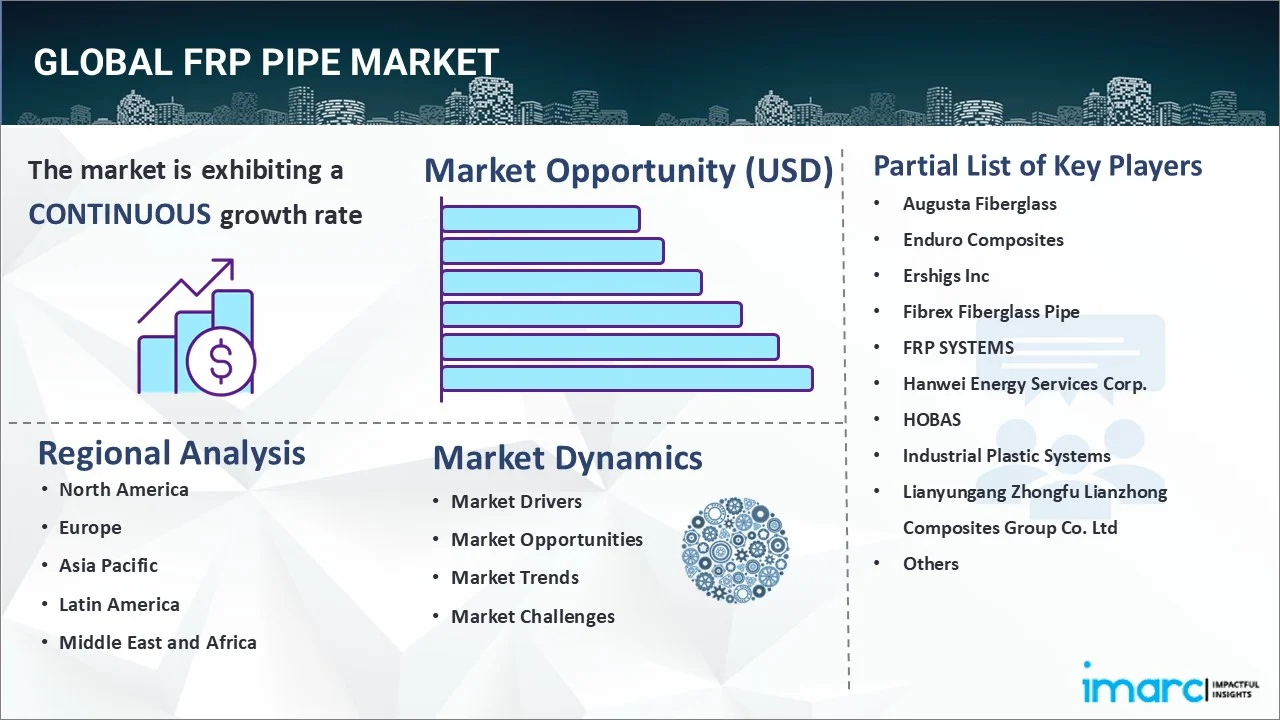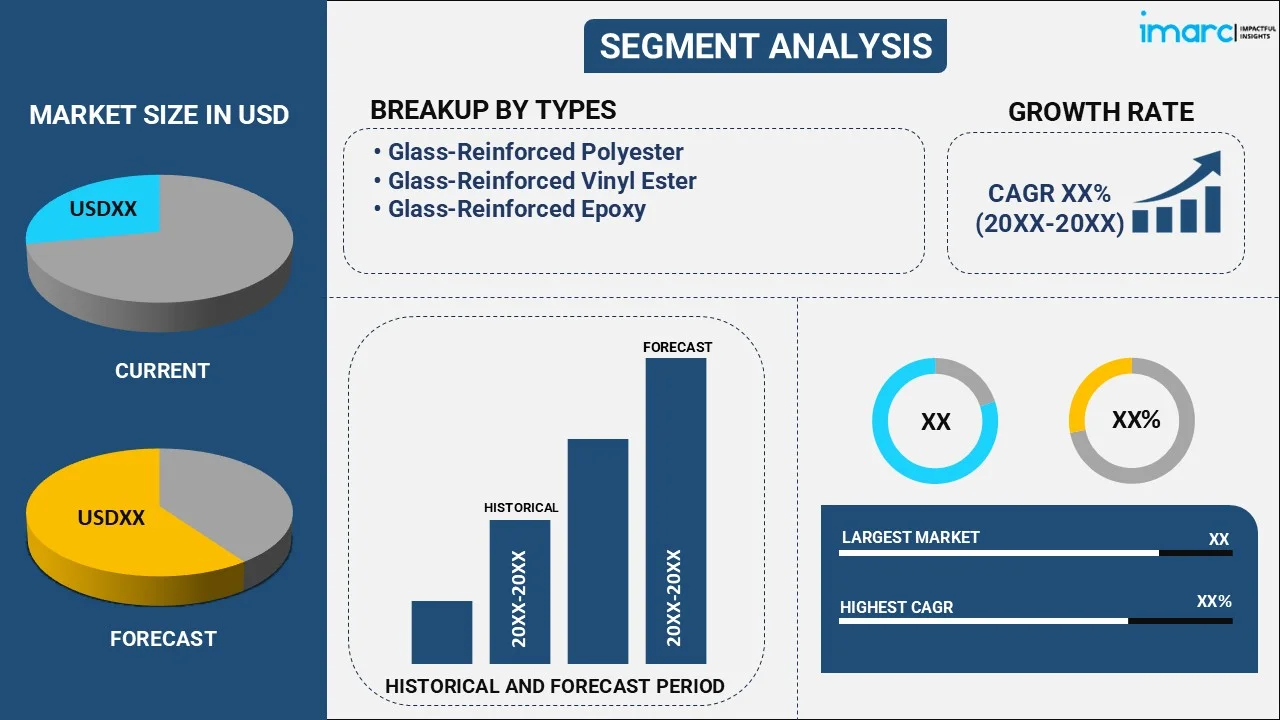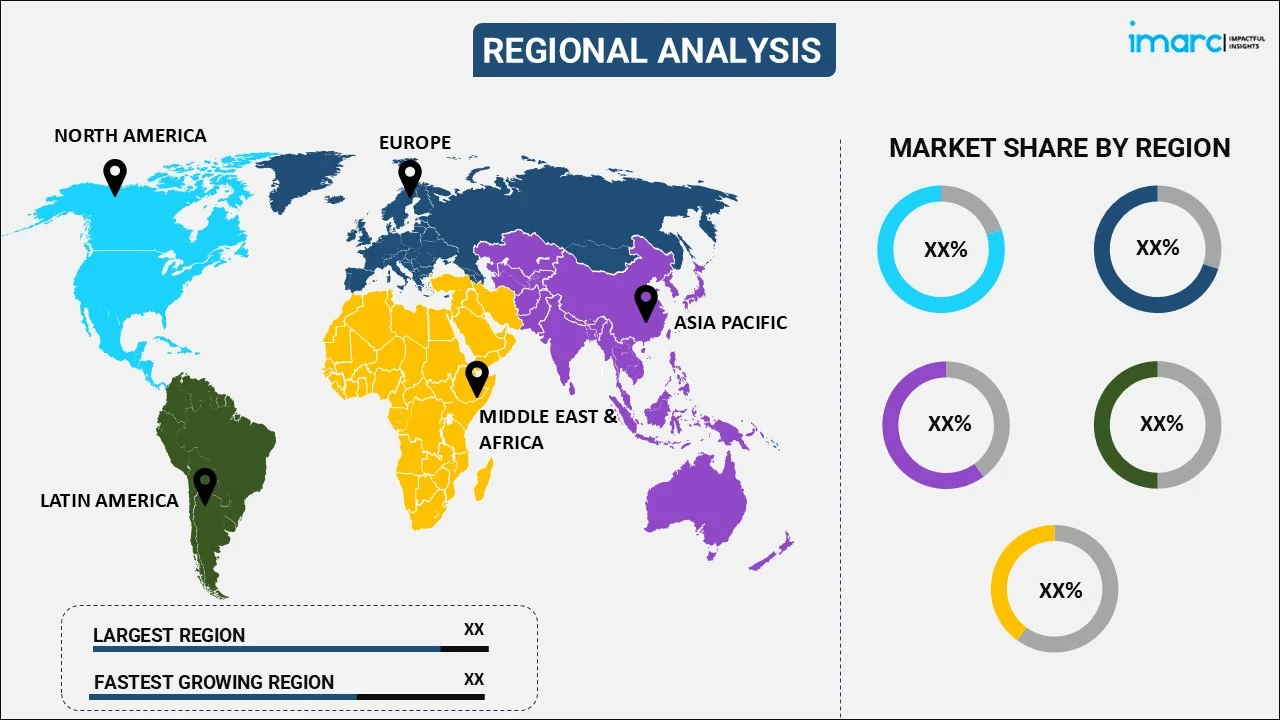
FRP Pipe Market Report by Type (Glass-Reinforced Polyester, Glass-Reinforced Vinyl Ester, Glass-Reinforced Epoxy), Manufacturing Process (Centrifugal Casting, Filament Winding, Pultrusion, and Others), Application (Water and Wastewater, Chemical and Industrial, Oil and Gas, Power Generation, and Others), and Region 2025-2033
FRP Pipe Market Size:
The global FRP pipe market size reached USD 4.35 Billion in 2024. Looking forward, IMARC Group expects the market to reach USD 5.94 Billion by 2033, exhibiting a growth rate (CAGR) of 3.51% during 2025-2033. The increasing demand for lightweight, corrosion-resistant material in several industries, the rising need for durable piping solutions in oil and gas, water and wastewater, and chemical sectors, growing environmental regulations, and rising infrastructure development are some of the major factors propelling the growth of the market.
|
Report Attribute
|
Key Statistics
|
|---|---|
|
Base Year
|
2024
|
|
Forecast Years
|
2025-2033
|
|
Historical Years
|
2019-2024
|
|
Market Size in 2024
|
USD 4.35 Billion |
|
Market Forecast in 2033
|
USD 5.94 Billion |
| Market Growth Rate 2025-2033 | 3.51% |
FRP Pipe Market Analysis:
- Major Market Drivers: The rising demand for lightweight, durable, and corrosion-resistant piping solutions across various industries such as oil & gas chemical processing, and water & wastewater management represent the major driver of the market. the growing infrastructure development and modernization efforts globally are increasing the adoption of FRP pipes which offer superior performance compared to traditional material.
- Key Market Trends: The increasing focus on research and development (R&D) to enhance the properties and performance of FRP pipes represents the key trends in the market. Innovations in resin formulations and manufacturing processes are leading to more efficient and cost-effective products. The market is also witnessing a shift towards customized solutions tailored to specific industry requirements.
- Geographical Trends: Asia Pacific accounts for the largest region in the FRP pipe market growth. Rapid industrialization, increasing demand for lightweight, corrosion-resistant material in sectors such as oil and gas, water and wastewater, and chemical processing, and extensive infrastructure development are driving the growth of the market across the Asia Pacific region.
- Competitive Landscape: Some of the major market players in the FRP pipe industry include Augusta Fiberglass, Enduro Composites, Ershigs Inc, Fibrex Fiberglass Pipe, FRP SYSTEMS, Hanwei Energy Services Corp., HOBAS, Industrial Plastic Systems, Lianyungang Zhongfu Lianzhong Composites Group Co. Ltd, NOV Inc., Sarplast, Saudi Arabian Amiantit Co., Shawcor Ltd., among many others.
- Challenges and Opportunities: The market faces several challenges such as high initial costs compared to traditional materials, limited awareness about its benefits, and technical complexities in installation and maintenance. However, the market also faces various opportunities including increasing demand for durable, corrosion-resistant piping solutions in various industries and innovations in manufacturing processes and material formulations.

FRP Pipe Market Trends:
Corrosion Resistance and Durability
FRP pipes offer superior resistance to corrosion and chemicals, making them ideal for use in harsh environments such as chemical processing, oil & gas, and wastewater management, thereby extending the lifespan of the infrastructure. According to IFC, India’s chemical and petrochemical (CPC) industry holds a significant position in the world market, worth 178 billion USD, and it is expected to grow to about 300 billion USD by 2025. According to Enerdata, in 2022, global crude oil production increased by a record 5.4% rate, much above its 2021 growth (+1.6%) and its 2010-2019 average (+1.3%/year), in a context of global economic growth and progressive OPEC+ crude oil production adjustment (+0.4 mb/d each month until phasing out the 5.8 mb/d production adjustment). This is expected to fuel the FRP pipes market statistics significantly.
Growing Demand for Water and Wastewater Treatment
FRP pipes are widely used in conveying potable water, sewage, and industrial effluents. This, along with its extensive utilization in desalination plants is further driving the demand for FRP pipes. According to the data from the International Trade Administration, various governmental initiatives, such as the Atal Mission for Rejuvenation and Urban Transformation, National Mission for Clean Ganga, Jal Jeevan Mission, and Community Drinking Water Schemes, contribute to the growth of the Indian water and wastewater treatment market. The Indian government created the Jal Shakti Ministry, bringing all water-related agencies under one ministry to provide safe drinking water to the people of India. Soon after it was founded, the Jal Shakti Ministry launched the Jal Jeevan Mission, designed to provide piped drinking water to 146 million households in 700,000 villages by 2024. Such initiatives are facilitating the application of FRP pipes, thereby contributing to the market growth.
Rising Environmental and Regulatory Concerns
The increasing environmental awareness and stringent regulations promoting the use of sustainable and eco-friendly materials are driving the adoption of FRP pipes in various industries, supporting market growth. For instance, in May 2024, BASF, the world's leading chemical company, is committed to a sustainable future and has set itself the ambitious goal of reducing its Scope 3.1 emissions by 15% across its entire portfolio by 2030 and achieving net zero by 2050. This is only possible by procuring raw materials with reliable PCF (Product Carbon Footprint) primary data and raw materials with a reduced PCF. One of the first steps is the partial use of glass fibers from sustainable production in BASF’s Ultramid® A & B compound portfolio. These glass fibers are produced by 3B Fibreglass, a leading company and supplier of glass fiber solutions for the reinforcement of thermoplastic and thermoset polymers. To reduce its carbon footprint, it uses green electricity in production.
FRP Pipe Market Segmentation:
IMARC Group provides an analysis of the key trends in each segment of the market, along with forecasts at the global, regional, and country levels for 2025-2033. Our report has categorized the market based on type, manufacturing process, and application.
Breakup by Type:

- Glass-Reinforced Polyester
- Glass-Reinforced Vinyl Ester
- Glass-Reinforced Epoxy
Glass-reinforced epoxy accounts for the majority of the market share
The report has provided a detailed breakup and analysis of the market based on the type. This includes glass-reinforced polyester, glass-reinforced vinyl ester, and glass-reinforced epoxy. According to the report, glass-reinforced epoxy represented the largest segment.
The demand for glass-reinforced epoxy (GRE) FRP pipes is driven by their exceptional mechanical strength and corrosion resistance, making them ideal for harsh environments in industries like oil and gas, chemicals, and marine applications. GRE pipes are lightweight yet robust, facilitating easier transportation and installation. Their low maintenance requirements and long service life reduce operational costs. Additionally, GRE pipes can withstand high pressures and temperatures, enhancing their suitability for demanding applications. The growing focus on durable and cost-effective piping solutions further propels the demand for GRE FRP pipes.
Breakup by Manufacturing Process:
- Centrifugal Casting
- Filament Winding
- Pultrusion
- Others
Filament winding holds the largest share of the industry
A detailed breakup and analysis of the market based on the manufacturing process have also been provided in the report. This includes centrifugal casting, filament winding, pultrusion, and others. According to the report, filament winding accounted for the largest market share.
The demand for FRP pipes in the filament winding manufacturing process is influenced by their superior strength-to-weight ratio, making them ideal for high-pressure applications. The precision and consistency of the filament winding technique ensure high-quality and uniform pipe production. FRP pipes' resistance to corrosion and chemical attack makes them suitable for harsh environments in industries like oil and gas, chemicals, and water treatment. The filament winding process allows for customized designs and dimensions, meeting specific project requirements and enhancing their appeal in various industrial applications.
Breakup by Application:
- Water and Wastewater
- Chemical and Industrial
- Oil and Gas
- Power Generation
- Others
The report has provided a detailed breakup and analysis of the market based on the application. This includes water and wastewater, chemical and industrial, oil and gas, power generation, and others.
The demand for FRP pipes in water and wastewater sectors is driven by their corrosion resistance, lightweight nature, and durability. These pipes are ideal for transporting potable water and sewage, and they are increasingly used in desalination plants due to their long service life and low maintenance needs.
In chemical and industrial sectors, FRP pipes are favored for their ability to withstand highly corrosive environments and chemical exposures. Their non-reactive nature ensures safe transport of aggressive chemicals and waste products, enhancing operational safety and reducing downtime and repair costs in harsh industrial processes.
FRP pipes are in demand in the oil and gas industry for their high strength-to-weight ratio, corrosion resistance, and ability to handle extreme temperatures and pressures. They are used in transporting crude oil, natural gas, and refined products, as well as in offshore platforms and subsea pipelines, enhancing efficiency and safety.
In power generation, FRP pipes are crucial for cooling water systems, flue gas desulfurization, and chemical feed lines. Their resistance to high temperatures, chemicals, and corrosion makes them ideal for demanding power plant environments, contributing to improved plant reliability, reduced maintenance costs, and extended service life.
Breakup by Region:

- North America
- United States
- Canada
- Asia-Pacific
- China
- Japan
- India
- South Korea
- Australia
- Indonesia
- Others
- Europe
- Germany
- France
- United Kingdom
- Italy
- Spain
- Russia
- Others
- Latin America
- Brazil
- Mexico
- Others
- Middle East and Africa
Asia Pacific leads the market, accounting for the largest FRP pipe market share
The report has also provided a comprehensive analysis of all the major regional markets, which include North America (the United States and Canada); Europe (Germany, France, the United Kingdom, Italy, Spain, Russia, and others); Asia Pacific (China, Japan, India, South Korea, Australia, Indonesia, and others); Latin America (Brazil, Mexico, and others); and the Middle East and Africa. According to the report, Asia Pacific represents the largest regional market for FRP pipe.
Rapid urbanization, rising industrialization, and growing infrastructure development are influencing the growth of the market across the Asia Pacific region. The increasing demand for corrosion-resistant and durable piping solutions in industries including chemicals, water treatment, and oil and gas are contributing to the market growth in the region. For instance, in May 2022, Altrad announced the proposed acquisition of FRP, a Singapore-based national business, as part of the company's strategy to grow in the Asia Pacific region through an expanded service offering and physical footprint.
Competitive Landscape:
- The market research report has also provided a comprehensive analysis of the competitive landscape in the market. Detailed profiles of all major companies have also been provided. Some of the major market players in the FRP pipe industry include Augusta Fiberglass, Enduro Composites, Ershigs Inc, Fibrex Fiberglass Pipe, FRP SYSTEMS, Hanwei Energy Services Corp., HOBAS, Industrial Plastic Systems, Lianyungang Zhongfu Lianzhong Composites Group Co. Ltd, NOV Inc., Sarplast, Saudi Arabian Amiantit Co., Shawcor Ltd.
(Please note that this is only a partial list of the key players, and the complete list is provided in the report.)
- The competitive landscape of the FRP pipe market is highly competitive with major players like Amiantit, Future Pipe Industries, and National Oilwell Varco dominating the industry. These players emphasize innovations, mergers, and expansion to strengthen their market positions. Regional players also contribute significantly, particularly in emerging markets. For instance, in April 2024, Hobas Pipe USA, Inc., North America's leading manufacturer of corrosion-resistant fiberglass pipe products, announced an expansion of its production capabilities with the addition of a second manufacturing line. This expansion, set to be operational by October 1, 2024, increases capacity to meet the escalating demands of the water and wastewater infrastructure sectors.
FRP Pipe Market News:
- In February 2023, Creative Composites Group (CCG) a leading manufacturer of Fiber Reinforced Polymer (FRP) composites, announced that the group has acquired Enduro Composites, a leading manufacturer of FRP products since 1954 based in Houston, Texas.
- In August 2023, EVR Advertising, an advertising and marketing agency recognized for its data-driven insights and strategic marketing solutions, proudly announced its partnership with Advanced FRP Systems, a leading industrial manufacturing company specializing in innovative repairs for industrial tanks, pipes, coatings, and infrastructure.
- In April 2023, Tenaris completed its acquisition of Mattr’s pipe coating business unit (Shawcor) for US $182.6 million (including estimated working capital and US$16.9 million in cash).
- In February 2022, Tatneft announced to build a new plant to produce fiberglass pipes Tatneft-Press Composite in Bavly. Two production lines with a total capacity of 1800 km of pipes per year will be installed on the site.
- In January 2024, Fibergrate Composite Structures, Inc. announced the inclusion of Microban® antimicrobial technology on various fiberglass-reinforced plastic (FRP) products. Microban® can help to inhibit the growth of damaging bacteria on FRP products.
FRP Pipe Market Report Scope:
| Report Features | Details |
|---|---|
| Base Year of the Analysis | 2024 |
| Historical Period | 2019-2024 |
| Forecast Period | 2025-2033 |
| Units | Billion USD |
| Scope of the Report | Exploration of Historical Trends and Market Outlook, Industry Catalysts and Challenges, Segment-Wise Historical and Future Market Assessment:
|
| Types Covered | Glass-Reinforced Polyester, Glass-Reinforced Vinyl Ester, Glass-Reinforced Epoxy |
| Manufacturing Process Covered | Centrifugal Casting, Filament Winding, Pultrusion, Others |
| Applications Covered | Water and Wastewater, Chemical and Industrial, Oil and Gas, Power Generation, Others |
| Region Covered | Asia Pacific, Europe, North America, Latin America, Middle East and Africa |
| Countries Covered | United States, Canada, Germany, France, United Kingdom, Italy, Spain, Russia, China, Japan, India, South Korea, Australia, Indonesia, Brazil, Mexico |
| Companies Covered | Augusta Fiberglass, Enduro Composites, Ershigs Inc, Fibrex Fiberglass Pipe, FRP SYSTEMS, Hanwei Energy Services Corp., HOBAS, Industrial Plastic Systems, Lianyungang Zhongfu Lianzhong Composites Group Co. Ltd, NOV Inc., Sarplast, Saudi Arabian Amiantit Co., Shawcor Ltd., etc. |
| Customization Scope | 10% Free Customization |
| Post-Sale Analyst Support | 10-12 Weeks |
| Delivery Format | PDF and Excel through Email (We can also provide the editable version of the report in PPT/Word format on special request) |
Key Benefits for Stakeholders:
- IMARC’s industry report offers a comprehensive quantitative analysis of various market segments, historical and current market trends, market forecasts, and dynamics of the FRP pipe market from 2019-2033.
- The research report provides the latest information on the market drivers, challenges, and opportunities in the global FRP pipe market.
- The study maps the leading, as well as the fastest-growing, regional markets. It further enables stakeholders to identify the key country-level markets within each region.
- Porter's five forces analysis assists stakeholders in assessing the impact of new entrants, competitive rivalry, supplier power, buyer power, and the threat of substitution. It helps stakeholders to analyze the level of competition within the FRP pipe industry and its attractiveness.
- The competitive landscape allows stakeholders to understand their competitive environment and provides insight into the current positions of key players in the market.
Key Questions Answered in This Report
The global FRP pipe market was valued at USD 4.35 Billion in 2024.
We expect the global FRP pipe market to exhibit a CAGR of 3.51% during 2025-2033.
The rising utilization of FRP pipes in various industries, including construction, chemical, oil and gas, etc., as they incur low investment and pumping costs, is primarily driving the global FRP pipe market.
The sudden outbreak of the COVID-19 pandemic had led to the implementation of stringent lockdown regulations across several nations, resulting in the temporary closure of numerous manufacturing units for FRP pipes.
Based on the type, the global FRP pipe market has been segregated into glass-reinforced polyester, glass-reinforced vinyl ester, and glass-reinforced epoxy. Among these, glass-reinforced epoxy currently exhibits clear dominance in the market.
Based on the manufacturing process, the global FRP pipe market can be bifurcated into centrifugal casting, filament winding, pultrusion, and others. Currently, filament winding holds the largest market share.
On a regional level, the market has been classified into North America, Asia-Pacific, Europe, Latin America, and Middle East and Africa, where Asia-Pacific currently dominates the global market.
Some of the major players in the global FRP pipe market include Augusta Fiberglass, Enduro Composites, Ershigs Inc, Fibrex Fiberglass Pipe, FRP SYSTEMS, Hanwei Energy Services Corp., HOBAS, Industrial Plastic Systems, Lianyungang Zhongfu Lianzhong Composites Group Co. Ltd, NOV Inc., Sarplast, Saudi Arabian Amiantit Co., and Shawcor Ltd.
Need more help?
- Speak to our experienced analysts for insights on the current market scenarios.
- Include additional segments and countries to customize the report as per your requirement.
- Gain an unparalleled competitive advantage in your domain by understanding how to utilize the report and positively impacting your operations and revenue.
- For further assistance, please connect with our analysts.
 Inquire Before Buying
Inquire Before Buying
 Speak to an Analyst
Speak to an Analyst
 Request Brochure
Request Brochure
 Request Customization
Request Customization




.webp)




.webp)












